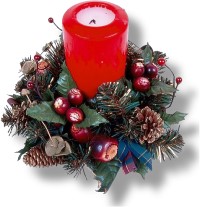In the morning of Christmas Day (25 December), children usually get up very early to unwrap their presents. Then they have plenty of time to play with their new toys.
Christmas dinner is served in the early afternoon. Most people eat turkey and sprouts and a Christmas pudding.
26 December is called Boxing Day. It hasn’t always been a holiday. People used to go back to work on that day where their bosses gave them little Christmas presents in small boxes. That’s why the day is called Boxing Day.
Ireland, like most countries, has a number of Christmas traditions that are all of its own. Many of these customs have their root in the time when the Gaelic culture and religion of the country were being supressed and it is perhaps because of that they have survived into modern times.
The Candle in the Window
 The
placing of a lighted candle in the window of a house on Christmas eve
is still practised today. It has a number of purposes but primarily it
was a symbol of welcome to Mary and Joseph as they travelled looking for
shelter.
The
placing of a lighted candle in the window of a house on Christmas eve
is still practised today. It has a number of purposes but primarily it
was a symbol of welcome to Mary and Joseph as they travelled looking for
shelter.The candle also indicated a safe place for priests to perform mass as, during Penal Times this was not allowed.
The Laden Table
After evening meal on Christmas eve the kitchen table was again set and on it were placed a loaf of bread filled with caraway seeds and raisins, a pitcher of milk and a large lit candle. The door to the house was left unlatched so that Mary and Joseph, or any wandering traveller, could avail of the welcome.The Wren Boy Procession
During Penal Times there was once a plot in a village against the local soldiers. They were surrounded and were about to be ambushed when a group of wrens pecked on their drums and awakened the soldiers. The plot failed and the wren became known as “The Devil’s bird”.On St. Stephens Day a procession takes place where a pole with a holly bush is carried from house to house and families dress up in old clothes and with blackened faces. In olden times an actual wren would be killed and placed on top of the pole.
This custom has to a large degree disappeared but the tradition of visiting from house to house on St. Stephens Day has survived and is very much part of Christmas.
Decorations:
The placing of a ring of Holly on doors originated in Ireland as Holly was one of the main plants that flourished at Christmas time and which gave the poor ample means with which to decorate their dwellings.All decorations are traditionally taken down on Little Christmas (January 6th.) and it is considered to be bad luck to take them down beforehand.

Nessun commento:
Posta un commento